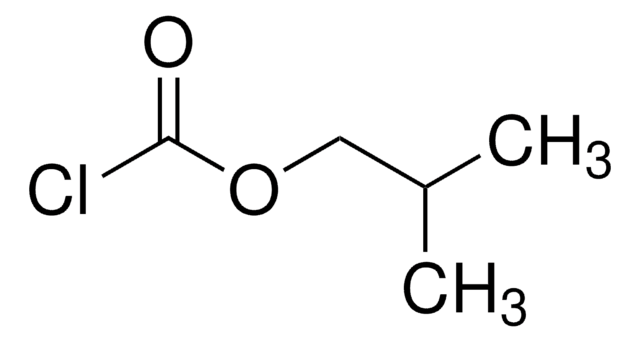401730
Methyl 10-chloro-10-oxodecanoate
97%
Synonym(s):
Methyl sebacoyl chloride
Sign Into View Organizational & Contract Pricing
All Photos(1)
About This Item
Linear Formula:
ClCO(CH2)8CO2CH3
CAS Number:
Molecular Weight:
234.72
MDL number:
UNSPSC Code:
12352100
PubChem Substance ID:
NACRES:
NA.22
Recommended Products
Assay
97%
form
liquid
refractive index
n20/D 1.453 (lit.)
bp
159-160 °C/9 mmHg (lit.)
density
1.052 g/mL at 25 °C (lit.)
functional group
acyl chloride
ester
SMILES string
COC(=O)CCCCCCCCC(Cl)=O
InChI
1S/C11H19ClO3/c1-15-11(14)9-7-5-3-2-4-6-8-10(12)13/h2-9H2,1H3
InChI key
ZUUUAAZQEMFVSN-UHFFFAOYSA-N
General description
Methyl 10-chloro-10-oxodecanoate (Methyl sebacoyl chloride, 10-Oxo-10-chlorodecanoic acid methyl ester) is a monomethyl ester of sebacinic acid.
Application
Methyl 10-chloro-10-oxodecanoate may be used in the preparation of the following:
- methyl 10-[2-methoxy-4-(3-trifluoromethyl-3H-diazirin-3-yl)phenyl]-10-oxodecanoate
- fluorescein-derivatives of Necrostatin-3
- methyl 10-oxo-10-(Pyren-3-yl)decanoate
Signal Word
Danger
Hazard Statements
Precautionary Statements
Hazard Classifications
Skin Corr. 1B
Storage Class Code
8A - Combustible corrosive hazardous materials
WGK
WGK 3
Flash Point(F)
159.8 °F - closed cup
Flash Point(C)
71 °C - closed cup
Personal Protective Equipment
dust mask type N95 (US), Eyeshields, Gloves
Choose from one of the most recent versions:
Already Own This Product?
Find documentation for the products that you have recently purchased in the Document Library.
Wallace Thompson et al.
Methods in molecular biology (Clifton, N.J.), 861, 149-158 (2012-03-20)
Attempts to characterize, quantify, and/or modulate the activity of the secreted phospholipase A(2) family of enzymes result from the diversity of physiological roles for which these enzymes have been implicated. The 1-palmitoyl-2-(10-pyrenedecanoyl)-phosphatidylglycerol (pyrenePG)-based fluorometric assay is a sensitive and readily
Effective synthesis of a carbon-linked diazirinyl fatty acid derivative via reduction of the carbonyl group to methylene with triethylsilane and trifluoroacetic acid.
Hashimoto M, et al.
Heterocycles, 59(1), 395-398 (2003)
Jenny L Maki et al.
Analytical biochemistry, 427(2), 164-174 (2012-06-05)
Necrotic cell death is prevalent in many different pathological disease states and in traumatic injury. Necroptosis is a form of necrosis that stems from specific signaling pathways, with the key regulator being receptor interacting protein 1 (RIP1), a serine/threonine kinase.
Our team of scientists has experience in all areas of research including Life Science, Material Science, Chemical Synthesis, Chromatography, Analytical and many others.
Contact Technical Service









